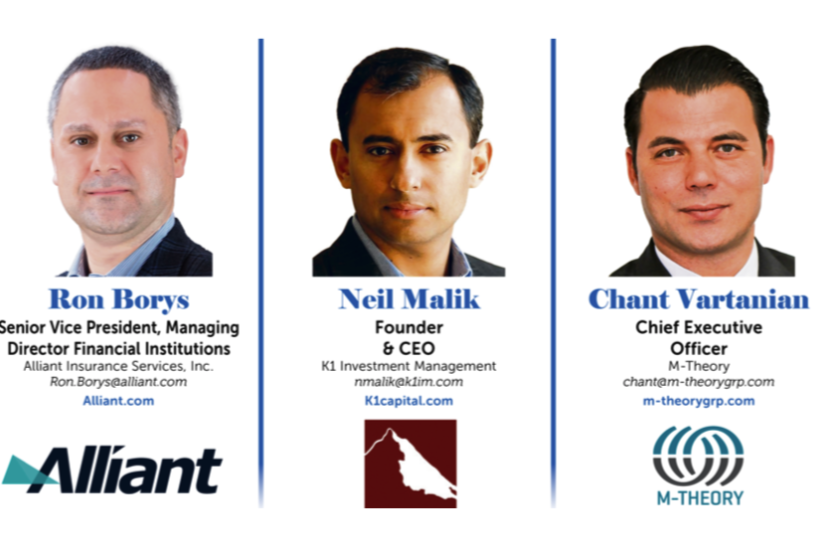Tony Barletta, Will Chuchawat and David Sutton Share Insights on Private Equity and M&A Strategies
- Share via
The Private Equity and M&A Strategies roundtable is produced by the L.A. Times B2B Publishing team in conjunction with BakerHostetler, GHJ and The Nuvo Group, Inc.
After the many unprecedented operational changes that businesses in every sector had to make over the last three years, new factors continue to arise in terms of managing private equity or taking the plunge for a merger or acquisition. The economic climate has also forced companies to make changes to the way they do business and the way they approach their fiscal needs.
To address these issues and uncover the latest trends in the management of private equity and the merger and acquisition landscape, the Los Angeles Times B2B Publishing team turned to three uniquely knowledgeable professionals for their thoughts about the most important “need to know” insights and to get their assessments regarding the various trends that they have been observing in general.
Q: What recent trends have been having the most impact on the private equity landscape in California?

Will Chuchawat, Co-Leader of M&A, BakerHostetler: Interest rates and lower growth expectations are having the biggest impact on the private equity landscape in California, though that is not a uniquely California issue. Perhaps the uniquely California issues stem from an increasingly anti-business environment and rising costs of doing business in California, whether that’s high labor costs, high taxes, high rents, high regulatory burdens, high risk of litigation, etc.

David Sutton, Private Equity Practice Leader, GHJ: In addition to broader domestic and international economics, California has been experiencing an exodus of businesses and consumers leaving the state. This is due to the growing cost of doing business, an increase in regulation, a stricter legal environment and a higher cost of living. California also suffered more than its fair share of disruption from logistics and weather patterns. However, California remains a highly innovative economy. It is home to Silicon Valley and much of the U.S. emerging technology markets, health and wellness innovation and consumer demand; and a significant agriculture market, which has high barriers to entry and inclement weather requirements. Six of the top 10 counties invested in private equity in the U.S. are in California.
Q: What are some of the biggest mistakes made by companies seeking a private equity investment?

Tony Barletta, Co-Owner & Managing Partner, The Nuvo Group, Inc.: Some of the biggest mistakes made by companies seeking a private equity investment include inadequate preparation and due diligence, unrealistic valuations, poor communication and lack of transparency, and failure to align interests and expectations with the private equity firm. These mistakes can lead to failed deals, strained relationships, and missed opportunities for growth and success. It is crucial for companies to carefully navigate the private equity landscape and avoid these pitfalls in order to maximize the potential benefits of a private equity investment.
Chuchawat: One of the biggest mistakes of companies seeking PE investment is not doing diligence on the private equity firm that they are taking money from. If you were going to bring a partner into your business, you would do diligence on them. Yet most companies fail to do due diligence on their future (private equity) partners.
Sutton: Many companies fail to get a private equity deal done because they are just not prepared for the level of depth to which a PE investor will go to understand that business and have investment committees sign off on the thesis and valuation - or they are able to get a deal done but leave value on the table. Oftentimes this is as straightforward as not performing pre-emptive diligence to get ready for counterparty scrutiny, and sometimes it is not investing in the business in the five years prior to build the necessary people and systems that give an investor a roadmap to growth. Pre-emptive diligence adds value to sellers by understanding what buyers will be looking for, presenting in a way to maximize value and getting ahead of any deal-critical issues before buyer diligence.
Q: What is the current state of the M&A landscape in 2023?
Chuchawat: The M&A market is confused. Where’s the recession that we’ve been waiting so long for? The Fed keeps trying to slow the economy and yet it’s stubbornly resilient. Volumes are down significantly, but that is measured against all-time highs. We haven’t returned to the Dark Ages. So much of dealmaking is psychology or sentiment. No one wants to do a deal when everyone is portending doom - you’d look stupid (if you’re wrong) for going against market sentiment. But with market sentiment improving in 2023, the M&A market will improve.
In the current M&A environment, debt leverage is more expensive and is resulting in a refocus on organic value creation.
— David Sutton
Q: In what industries or sectors are you seeing the most M&A activity?
Barletta: M&A activity is currently thriving across various industries and sectors. The healthcare, technology, financial services, and retail sectors are the most common industries for mergers and acquisitions. With the rapid advancements in technology and the ever-increasing demand for innovative solutions, tech companies are actively seeking to expand their capabilities and market share. The healthcare sector also has been undergoing significant transformation, driven by factors such as changing demographics, regulatory changes, and the need for cost efficiencies. As a result, healthcare organizations are engaging in mergers and acquisitions to enhance their service offerings, improve patient outcomes, and achieve economies of scale. Additionally, the consumer goods sector has also witnessed a considerable amount of M&A activity. Companies in this sector are constantly looking for ways to expand their product portfolios, enter new markets, and gain a competitive edge.
Q: How would you describe the private equity market’s changes over the last couple of years?
Sutton: Turbulent. Markets have seen valuations swing wildly, with the cost of capital increasing several times over and the availability of debt capital significantly reduced, making acceptable returns much more difficult to find. The supply of quality companies willing and able to transact was also depleted by the volume of activity in 2022. Margins have also been impacted by record inflation with price increases proving difficult to pass on in the long term. If you put all of that together, organic growth will be the driver of PE returns in 2023 (and possibly 2024) while M&A markets recover. As such, talent markets and specifically high-caliber C-Suite roles will be a hugely important component of PE success in the short term.
Chuchawat: The private equity market has seen a dramatic shift from optimism to pessimism. PE players have had to contend with the shock of going from ~0% interest rates to ~5.5% rates. PE firms have been largely proactive in dealing with the increased interest burden and lenders have been cooperative with their borrowers, so fortunately there have not been a lot of distressed companies.
Q: What type of information do prospective investors ask for as part of due diligence that they didn’t ask for in the past?
Sutton: Diligence has become a longer, deeper exercise than ever before. Traditional areas of diligence such as financial and legal are taking longer and becoming more detailed and complex. In addition, emerging areas such as cyber diligence and ESG are becoming more common in the deal process than before but with room to become more standard. Deal structures are also changing, with increased deferred consideration, earnout structures, rollover equity or non-compete arrangements. These types of structures often require additional negotiation and, as a result, time and attention to get to a definitive agreement.
Barletta: Prospective investors now seek additional information during the due diligence process which includes a thorough analysis of the company’s financial statements, including balance sheets, income statements, cash flow statements, tax returns, legal documents, customer and employee contracts and much more. They also inquire about the company’s growth projections, market share and competitive advantage. Additionally, investors also now request detailed information on the company’s management team, including their qualifications and track record. Many investors are also interested in environmental, social and governance (ESG) factors more than they were in the past.
While 2023 has slumped, we need to widen our aperture and look at more than just year-over-year comps.
— Will Chuchawat
Q: What are some typical reasons why deals fail?
Sutton: While it is normal for buyers to submit a letter of inquiry (LOI) without fully securing funding, the current capital availability and pricing environment make the lack of debt or equity capital an increasing reason for deal failure. More typical examples involve legal, financial and environmental diligence findings that could have been addressed upfront. In many cases, early disclosure and/or crafting the appropriate dialogue could have navigated the issue. Lastly, specific events such as a customer loss, cybersecurity breach and broader economic changes are always a possibility and harder to navigate.
Barletta: There are several typical reasons why M&A deals fail. First, a lack of strategic fit between the two companies involved can be a major obstacle. If their goals, values or cultures are not aligned, it can lead to conflicts and difficulties in integrating the businesses. Second, poor due diligence can also contribute to deal failure. If the acquiring company fails to thoroughly assess the financial health, legal risks or operational challenges of the target company, it can result in unexpected problems post-merger. Lastly, inadequate communication and stakeholder management can undermine the success of an M&A deal. If employees, customers or investors are not properly informed and engaged throughout the process, it can lead to resistance, uncertainty, and ultimately, failure. The inability to retain key people can lead to a loss of knowledge and expertise.
Chuchawat: The most common reason that I’ve seen deals fail across more than 500 deals is underperformance of the target company during the diligence period. And remember, no matter what anyone says, diligence is never really over until the deal closes. So, companies need to keep their eyes on the ball and execute on the business while simultaneously tackling the deal process. It’s easier said than done. A smart buyer is not going to close if they see the target underperforming expectations.
It is important for C-suite executives to understand and align with the culture and style of private equity firms in order to effectively collaborate and achieve mutual goals.
— Tony Barletta
Q: What industry segments seem most attractive right now for private equity investors?
Sutton: Companies that have recurring, consistent revenues and margins with strong barriers to entry are always attractive to financial investors. For example, government contracts or other long-term contracting businesses, sticky customer bases such as contract manufacturing or high-volume businesses that are less susceptible to changes in customer concentration. In the current M&A environment, debt leverage is more expensive and is resulting in a refocus on organic value creation. Businesses that can be institutionalized (e.g., the business fundamentals are strong but there is value in building out the finance function, management team, systems, etc.) are also attractive opportunities. This can span almost any industry and is more thematic than it is industry-specific.
Q: What IT compliance risks and regulatory challenges are affecting the M&A process today?
Barletta: The M&A process today is facing several IT compliance risks and regulatory challenges. These include data privacy and security regulations, such as the General Data Protection Regulation (GDPR) and the California Consumer Privacy Act (CCPA), which require companies to protect personal data and inform individuals about data breaches. Additionally, there are industry-specific regulations, like the Health Insurance Portability and Accountability Act (HIPAA) for healthcare organizations that require strict compliance with data protection and privacy standards. Furthermore, the increasing use of cloud computing and outsourcing arrangements in M&A deals introduces challenges related to data ownership, control and access. Cyber incidents, pandemic outbreaks and natural disasters have also made clear that significant disruptions are increasingly likely to occur. It is crucial for organizations involved in M&A transactions to thoroughly assess and address these IT compliance risks and regulatory challenges to ensure a successful and compliant integration process.
Sutton: Compliance continues to challenge the M&A process, with expanding FTC/DOJ antitrust guidelines threatening to cover a greater range of transactions. Further, data privacy laws are and will continue to be an increased area of focus, especially with AI and LLMs providing more complexity and more risk which buyers may unknowingly inherit. Coupled with the evolution of cybersecurity threats, the IT compliance environment is growing more and more complex. The M&A diligence environment is responding to this, but buyers will need to be fully educated on what risks can and cannot be protected against pre-acquisition – it certainly will not be all of them.
Q: What should CEOs and other C-suite executives of growing companies be aware of regarding the culture and style of private equity firms?
Barletta: C-suite executives of growing companies should be aware that private equity firms have a distinct culture and style. They have a lot more skin in the game, so they feel the burn if they make a bad selection. Private equity firms typically focus on maximizing financial returns and value creation. They often have a short-term outlook and prioritize efficiency and profitability. They also tend to have a hands-on approach, actively managing their portfolio companies and making strategic decisions. It is important for C-suite executives to understand and align with the culture and style of private equity firms in order to effectively collaborate and achieve mutual goals. Private equity firms and their portfolio companies must be aligned in terms of goals, objectives and values. Failure to do so will result in conflicts and misunderstandings.
Q: What is your forecast for M&A activity volume for the next five years?
Chuchawat: We will hit a new record in M&A activity volume in the next five years. While 2023 has slumped, we need to widen our aperture and look at more than just year-over-year comps. The overall, longer-term trend in M&A has been undeniably positive growth.


